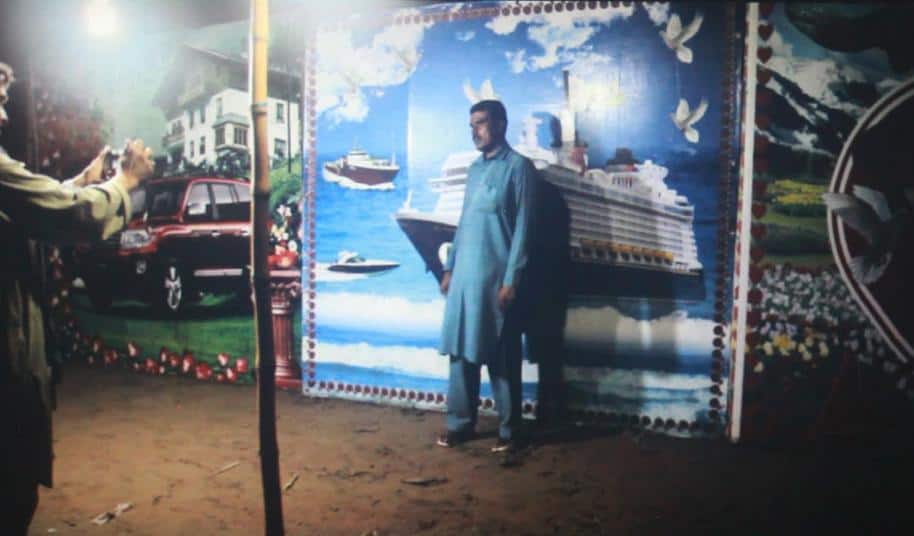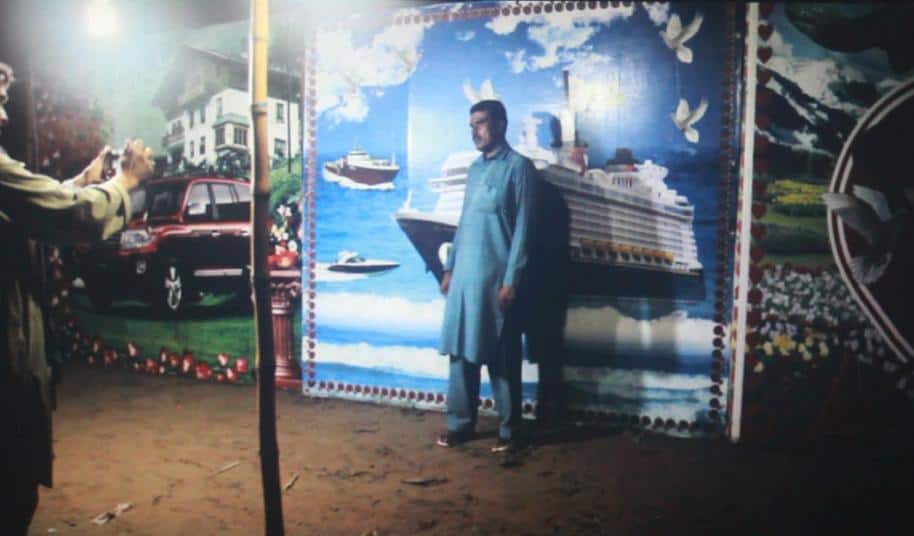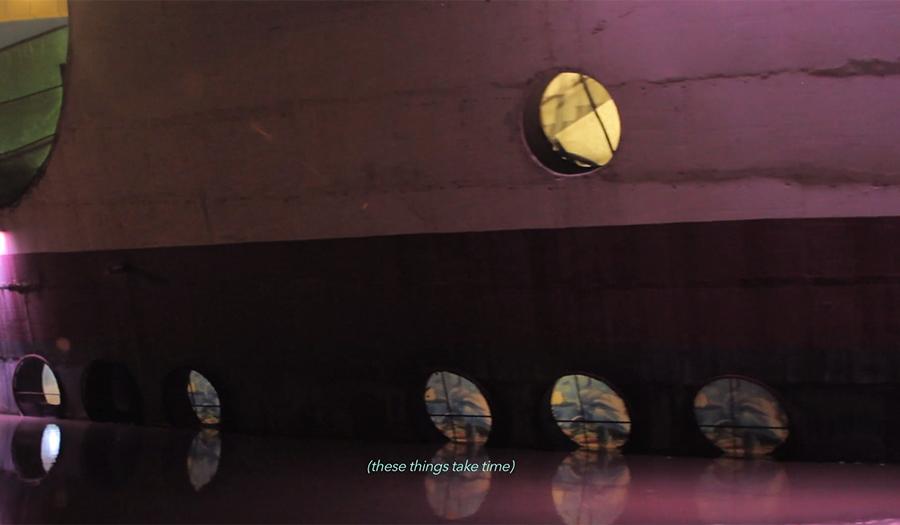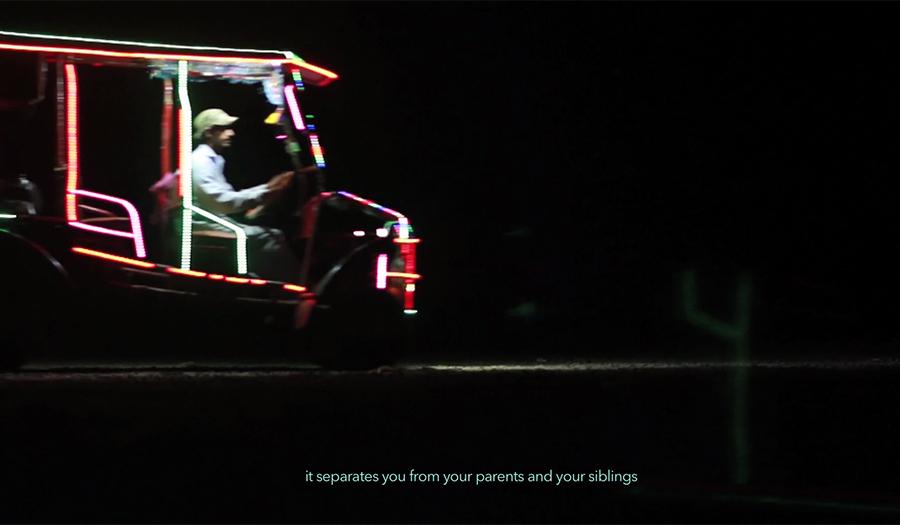
Yaminay Chaudhri: There was Nothing – Kuch bhi Naheen Tha!
Curated by Sarah Fritchey
April 5—April 27, 2019
Yaminay Chaudhri, Still from: There was Nothing – Kuch bhi Naheen Tha!, 2017. Single channel video, sound, 14 mins 15 secs.
Artspace is very pleased to present There was Nothing – Kuch bhi Naheen Tha!, a living archive of fleeting activity taking place along one of Pakistan’s most popular and rapidly gentrifying public beaches. For the past eight years, multimedia artist Yaminay Chaudhri has dedicated her practice to documenting the impact of rising global investment in speculative real estate in the port city of Karachi, Pakistan. These capital investments have privatized many of the city’s public commons, including sections of the beach, stripped mangrove habitats along the city’s waterfront for land reclamation, policed and removed informal local commerce, and displaced thousands of economically disadvantaged people in pursuit of development and progress. Chaudhri’s project archives informal vendors working on a shrinking section of the public Clifton beach called “Seaview” to understand how and why Karachi’s residents, even those who have the most to lose, are contributing to the effort to reimagine Karachi into a “worlding” global city.[1]
Chaudhri is uniquely attuned to the ways that local and foreign investment are transforming Karachi’s self-image and ecology. She grew up in Karachi in the 1980’s, witnessed the liberalization of the economy in the 1990’s, and trained and worked as a commercial architect in the 2000’s, before turning towards a highly collaborative and socially-engaged visual arts practice in 2010. Her family still lives in the middle class neighborhood of Darakhshan, where she returns to make work six months out of the year. Through her turn to the visual arts, Chaudhri has carved out a space for thinking about the emotional connection between the built environment and human desire. She uses the term “architectures of aspiration” to describe any structure (physical, emotional, virtual or invisible) that is projected as an image within a developing city and is symbolic of it’s residents’ aspirations of upward mobility. In her childhood neighborhood, for example, Chaudhri describes additions made to private homes (extended gardens, enclosed balconies, pitched roofs, extra bedrooms) as “architectures of aspiration”, where residents encroach into public space to increase their own investments. A print series of silhouettes of these houses, floating in fields of white, are included in the exhibition.
The main focus of this new body of work is a video on display inside Artspace’s Project Room. Shot on motorized buggies traversing a busy stretch of the beach at night, the work affectionately explores Karachi’s peculiar aesthetic and coastline economy. While no electrical grid is set up along the beach to power these informal businesses, the flashing LED lights of the buggies and glowing vendor stalls provide makeshift light. The setup is temporary and DIY– photo booths and hot food stands run on car batteries and cell phones double as flashlights for visitors who appear and disappear into the night. A cacophony of sounds, a melting pot of languages and sites further illuminate the scene, as do Karachi’s city lights looming in the background. The video captures the play between Karachi’s vernacular aesthetic and the new city aesthetic to come. The mood is light hearted but underwritten with a sense of imminent change. As one driver states, “to gain something, one has to lose something else.”
Since 2007, under the Karachi Strategic Development plan 2020, Karachi’s local government has worked with private investors to develop the city’s coastline into a world class tourist destination and modern housing settlement. Looking to Dubai and Singapore as models, this project is part of a beautification effort to clean and sanitize the beach of its less privileged publics. Already, many sections of Sea View have been enclosed by gated parks and public monuments encroaching on the beach. Further, the ongoing removal of informal vendors from most sections of the beach is creating sudden drops in local visitation, and lively zones of public entertainment. Simultaneously, Karachi is working to sanitize its historic center. Under the guise of historic preservation and infrastructural development, the city is removing Informal vendors from inside and around the central market, and resurrecting defunct railway lines laid by the British during colonization. These “improvements” come at the cost of displacing the vendors who make their living in the market, and the families who live over and around the rails.
At large, Chaudhri’s project documents the disappearing of a locally grown social and economic vernacular space that is on the brink of disappearance. It sheds light on how land development happens, often quite visibly, in open space, over somebody, at the loss of human and non-human ecology. Her project echoes the life cycle of other “worlding” cities who push to update their infrastructure to appeal to the spectacular demands of an international elite, or even an international aspiring class. Chaudhri understands this change as happening at the hands of an ideology that is ongoing and global, not limited to Karachi. In her words, “There’s an aspiration to have more, to be more, to think that you can’t survive through what you have. If you’re not part of the circuit, you’re going to be left behind.”
On Thursday, April 18 from 6-7:30pm, Chaudhri will present a lecture that examines aspiration and its alternate, exploring how a low-res image of a city might act as an insurgent to undermine the expectation of a “worlding” image.(I was not planning on talking about this overall backdrop and the new project but I guess I could…or we could leave it open in terms of content for now? I had a lecture performance on the insurgent low res image which exists as a kind of resistance against the expectations of a worlding image city but it is a more theoretical examination of aspiration and its alternate)
About the Artist
Yaminay Chaudhri (born in Karachi, Pakistan) is an artist with a background in architecture and multimedia studio arts. She uses public engagement, digital media and writing to explore Karachi as a site of emotional and physical architectures of longing, contestation and complicit class aspirations. While her current work seeks alternatives to these aspirations and the potential for insurgency in discarded bodies, she is constantly navigating the unstable nature of place, home and cities. The city of Karachi is the generator of many ideas, but while her work is site specific, similarities between Karachi and other developing cities allow viewers to empathize with the work on a broader scale.
Chaudhri has taught at Universities in the United States and Pakistan including SUNY Albany, Karachi University, Habib University and the Aga Khan University. She founded the Tentative Collective in Karachi in 2011, and her work, along with the work of the Collective has been shown in various local and international venues. She moved to Guilford, Connecticut in 2015, and lives and works between Connecticut and Karachi.
About Artspace’s Flatfile Collection
Yaminay Chaudhri is one of 125 artists represented in Artspace’s rotating Flatfile Collection of two-dimensional works on paper. The Collection was founded in 2000 as a way of bringing together artists who were based in the greater New Haven region, but has since grown to represent a regionally rich and nationally-based constituency. Each year, Artspace invites one Flatfile artist to mount an exhibition that draws upon the philosophies, theoretical approaches, processes or material concerns at the core of their practice. These exhibitions provide a space for viewers to get to know more about the artists in our Flatfile, contextualizing their works in the Flatfile with their practice at large. In turn, these exhibitions provide the exhibiting artist with an opportunity to explore the Flatfile as an ecosystem. During the run of the show, we ask that each artist activates a connection to fellow Flatfile artists or Artspace audiences in some way. The collection is viewable via our online directory at artspacenh.org/collection.asp, and the majority of the work is made within the past three years.
[1] Ananya Roy’s use of the term “worlding” or “worlding of the south” (from Martin Heidegger and later critiqued by Gayatri Spivak) is the most important way of sharing this transition of the global south as it begins to participate in and present itself as an image — in the sense of ‘the world as image’. Source: Ananya Roy. 27 Marc 2014, Worlding the South from: The Routledge Handbook on Cities of the Global South Routledge. PDF Download: https://www.routledgehandbooks.com/pdf/doi/10.4324/9780203387832.ch3


